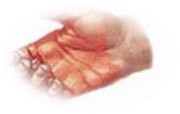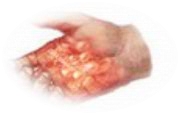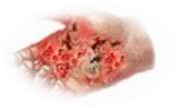|
The first step is to determine the degree of the burn and the damage to the skin.
Burns are categorized as first-, second-, or third-degree.
First-degree burn 
The least serious burns are those in which only the outer layer of skin is burned. The skin is usually red, with swelling and painful. The skin is dry without blisters.
Second-degree burn 
Second-degree burns are more serious and involve the skin layers beneath the top layer. These burns produce blisters, severe pain, and redness.
Third-degree burn
 This is the most serious burn. These burns are painless (due to nerve damage) and involve all layers of the skin. The burned area may be charred brown, leathery or appear dry and white. This is the most serious burn. These burns are painless (due to nerve damage) and involve all layers of the skin. The burned area may be charred brown, leathery or appear dry and white.
Important:
- Don't apply butter or ointments to the burn to ensure proper healing of the burned skin.
- Don't break blisters to prevent infection.
- Don't use ice to prevent destruction to the skin.
- Don't immerse large severe burns in cold water to prevent shock.
Call for emergency medical assistance for major burns. Until an emergency unit arrives, follow these steps:
- Make sure the victim is no longer in contact with the burning material or exposed to smoke or heat.
- Don't immerse large severe burns in cold water to prevent shock.
- Check for signs of circulation and if there is no breathing or other sign of circulation, proceed with CPR.
- If possible, raise the burned body part above heart level.
- Use a cool, moist bandage to cover the burned area.
 
|